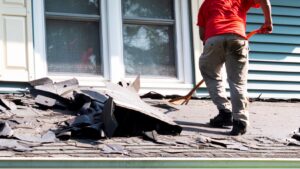Roof Repair Las Vegas NV addresses damage, leaks, or other issues that affect the integrity of the roof. During the repair process, a roofing professional may also recommend a protective coating for the roof.

Depending on the severity of the issue, repairs could include replacing missing shingles, patching leaks, or reinforcing structural elements. In addition, the flashing around chimneys and vents might be re-caulked to prevent water leaks.
Shingles are durable and meant to withstand a lot of wear and tear, but they’re not infallible. High winds and hail can damage or loosen shingles, making them susceptible to leaks. If your roof is leaking, it’s important to have damaged shingles repaired right away.
Cracking is another common shingle problem that can be caused by a variety of factors. These include temperature changes, dryness over time, and aging. Cracking shingles can allow water to seep into your home, leading to other problems, such as ceiling and wall mold.
Curling shingles can also be an indication of roof damage. This type of shingle is less effective in protecting your home from the elements and can lead to a more costly repair bill down the road. It’s important to check the entire roof for these issues, as even just one damaged shingle can lead to further damage.
If you notice signs of shingle damage, there are a few things you can do to fix the issue. The first step is to remove the damaged shingle. You can do this by using a pry bar to slide underneath the shingle and lift it up, pulling it off the roof. Remove the nails that are holding it in place and then replace the shingle with a new one. Make sure you use roofing cement to cover the nail holes.
It’s also a good idea to inspect the rest of your roof and address any other repairs you might need. This can help prevent further issues and save you money in the long run.
While it may seem like an easy task to replace a single shingle, it’s best to hire a professional for this job. A professional will be able to ensure that the repair is done correctly and won’t lead to further issues down the road. They will also be able to determine whether the damaged shingle is in the middle of its lifespan or nearing the end. This will give you a better idea of how soon you’ll need to replace the rest of your shingles.
Leaks
Leaks are one of the most common signs that your roof is in need of repair. They can occur due to a number of reasons, including storm damage, damaged or missing shingles, attic venting, poor flashing details around penetrations, and even age-related issues. Fortunately, leaks are not usually permanent and can be repaired with relative ease if you catch them early enough. The best way to spot a leak is by looking for water stains on the ceiling and walls of your home.
If you notice this, it’s important to move any furniture and electronics that could be affected by the leak to a dry area. Also, make sure to place buckets or other containers under the leaking spots. Leaks can cause a lot of damage in a short amount of time, and you’ll want to act quickly to prevent further issues.
Once you’ve identified where the leak is coming from, you can take some steps to contain it until a professional can come out and do the repairs. Start by placing a tarp on the affected area. Be sure that it’s large enough to generously cover the problem spot and extend outward. You may also want to consider adding a border of cement around the edge of the tarp to further secure it and prevent leaks.
For a more permanent solution, consider replacing the broken or missing shingle or repairing the vent that’s allowing water into your attic space. You should also inspect the surrounding areas for any damage and re-seal any cracked or loose flashing.
If you notice any of these symptoms, it’s time to call a roofer for help. They can examine your roof to identify the source of the problem and recommend a proper course of action. Then, they can do the necessary repairs to ensure your building’s health and keep your family and pets safe. Make sure to schedule routine maintenance and inspections after any roof repairs, as well, to prevent future problems.
Sagging
While a little bit of roof sag isn’t always cause for alarm, ignoring this structural issue can lead to more serious problems down the road, including a weakened support structure or collapsed roof. This can lead to expensive repairs and potential property damage.
In some cases, a sagging roof can be resolved by jacking up loose rafters or adding struts and supports. However, it is important to consult with a professional before trying to fix a sagging roof yourself. Without proper knowledge or experience, you could end up damaging your roof even more. An experienced roofing contractor has the skills and expertise to assess the situation and provide a repair solution that will keep your home safe.
The first step in repairing a sagging roof is to find the source of the problem. This may involve examining the attic for signs of water damage or rot that could weaken the roof’s overall structure. If any rot or damage is found, it must be addressed before proceeding with the roof repair.
Once the cause of the sagging has been identified, a steel “L” channel can be used to reinforce and stabilize the broken rafters or trusses. The steel channel should be 2-3 feet long and fitted over the damaged truss or rafter. A lag bolt should then be screwed into each of the holes on the “L” channel. The length of the lag bolt should be longer than the distance between the two joists so that it can hold the weight of the roof.
Other repair options include sistering rafters, installing support brackets, and replacing any rotted or pest-damaged wood. It’s important to note that the most effective way to prevent sagging is to have regular roof inspections. This will allow you to catch any damages or repairs early on before they become a major problem. Contact Wegner Roofing for an expert roof inspection and repair that you can count on.
Dry Shingles
Roofing shingles and tiles are designed to withstand a lot of wear and tear, but they aren’t infallible. Intense heat, frequent precipitation, and aging factors can quickly lead to damage. As a result, roofs need regular inspection and repairs. Detecting problems early can extend the life of your roof and reduce heating and cooling expenses.
If you spot signs of roof damage, such as sagging areas or water leaks, you should seek a professional roofing contractor. However, it’s also important to learn how to spot and repair the most common types of roof repair issues yourself.
Start by examining your roof for missing shingles and loose ones. These gaps expose the underlying layers to the elements, and can cause further problems like interior water infiltration, mold growth, and lower insulation efficiency. Walk around the perimeter of your home and pay special attention to corners, eaves, and windows, where shingles may be more prone to loosening from structural movements or weather impacts.
When examining the condition of your shingles, gently press on them to test their flexibility. A flexible shingle can bend and expand to accommodate changing weather conditions, while a stiff one will crack or stain. Also look for granules that have begun to fall off, which can indicate the deterioration of shingles.
While a little cracking is normal, excessive deterioration can indicate that your shingles are near the end of their lifespans and require replacement. If your shingles are curled or cracked, use a putty knife to spread sealant over the cracks and smooth them out. Once the sealant has dried, sprinkle granules over the repair to match the texture of your shingles and help the patch blend in with the surrounding area.
Regular maintenance and prompt repair of damaged shingles can extend the life of your roof by years at a time. By performing regular inspections, addressing minor problems as they arise, and keeping gutters clear of debris, you can protect your home and belongings from water infiltration and other costly damage. In the long run, proper roof maintenance will also reduce your energy costs and protect your investment in your home or business.

